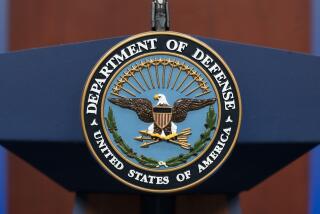In Afghanistan conflict, Pentagon considers structural changes
WASHINGTON — The Obama administration’s emphasis on the war in Afghanistan, including an influx of additional troops, has exposed weaknesses in U.S. military planning that top officers are scrambling to address.
The U.S. military command structure in Afghanistan was designed for a much smaller force. But with the increase ordered by President Obama, the number of U.S. troops will rise to 60,000 by the end of summer and is expected to reach 68,000; NATO troops are increasing to 35,000. The U.S.-led force needs a larger headquarters operation, military officials and experts said.
Some officials favor assigning a second commanding general with a large staff of officers -- similar to the approach taken when the number of troops was increased in Iraq in 2007.
The second general would coordinate U.S. and coalition military operations, enabling the current commander, Gen. David D. McKiernan, to work on efforts to train the Afghan military and improve government services.
“You need a general who is, day-to-day, committed to the fight -- an operational commander -- and a general who is, day-to-day, committed to the governance,” said a senior Defense official who spoke on condition of anonymity because the proposal is still under discussion.
In Iraq, the military’s headquarters was augmented by a cohesive group of officers, planners and soldiers reporting to a three-star commander.
“Afghanistan has not had the robust layer of planning,” the Defense official said.
The mission in Afghanistan has long been seen as secondary to Iraq, but the Pentagon is examining ways to overhaul the operation after months of advances by Taliban militants and extremists.
The Pentagon also is considering a radical shift in deployment cycles, assigning key leaders and planners to Afghanistan for as long as five years. They would be rotated in and out in nine-month stints, and probably would be placed in the same locations and jobs each time.
Adm. Michael G. Mullen, chairman of the Joint Chiefs of Staff, said in an e-mail interview that the changes were part of a “new strategy and a new commitment.”
Mullen drew wide attention in 2007 with his assessment of U.S. priorities, saying, “In Afghanistan, we do what we can. In Iraq, we do what we must.”
Now, however, Mullen said, Afghanistan is recognized as the larger challenge.
“It’s vital, and it directly affects our national interests,” he said. “From now on, it’s not about can-do, it’s about must-do.”
Obama has ordered 17,000 additional combat troops and 4,000 trainers into Afghanistan, and plans to send civilian experts to help improve the Afghan government. In addition, he is asking Congress for civilian aid for Pakistan as part of a broader regional plan.
Adding a command layer in Afghanistan to handle the troop buildup may suggest more red tape, but experts said it could make a difference.
“In my opinion, the command structure is not ready to absorb the additional troops,” said Marisa Cochrane, researcher for the Institute for the Study of War, an independent center in Washington.
“Some people say you are just adding a layer of bureaucracy,” she said. “But the added staff can help give you a better picture of the enemy across the whole theater.”
The proposals for a shift in deployment cycles represent a way to improve the knowledge and experience level of the people sent to Afghanistan.
Army Lt. Gen. Stanley McChrystal, a top Mullen aide who commanded special operations forces in Iraq, recommended the shift after examining military preparations for Afghanistan.
Under present policies, troops sent back for repeat deployments could be assigned as needed. Under the proposed policy, many would return to the same area and to similar jobs, gaining a deeper understanding of local people and issues.
“We need to do a better job bridging that gap, seeing things through their eyes -- knowing not just the terrain on the ground, but also the people who live there,” Mullen said in the e-mail interview.
John Nagl, a retired Army lieutenant colonel who heads the Center for a New American Security, said repeat tours in the same area were crucial to cultivating local ties while taking on insurgent groups.
“You get to know the people, you get to know the politics -- the human terrain as well as the geographic terrain,” Nagl said. “This is a long overdue effort in my opinion.”
The change would not apply to all troops, but to individual leaders and planners, as well as specialized units, said a senior military official who described the plans on condition of anonymity.
“We are looking for a group of people . . . with focused expertise,” the official said. “It is to avoid re-learning everything over and over.”
--
More to Read
Sign up for Essential California
The most important California stories and recommendations in your inbox every morning.
You may occasionally receive promotional content from the Los Angeles Times.










